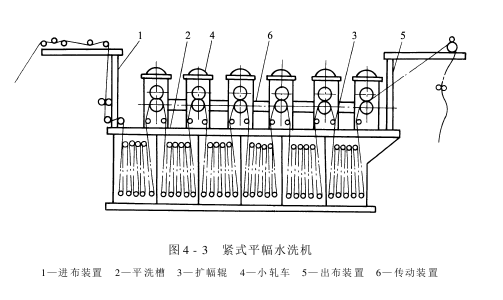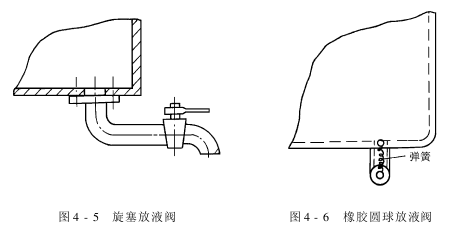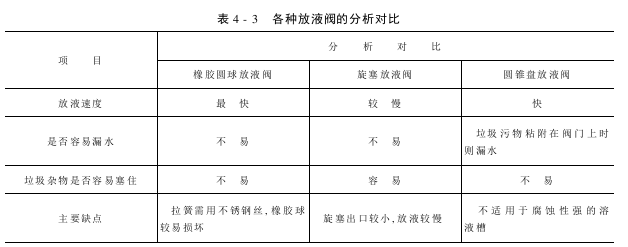Open-width washing machine – ordinary open-width washing machine
The open-width washing machine, referred to as the flat-width washing machine, is used for cleaning open-width fabrics. It is one of the main unit machines for finishing equipment such as scouring and bleaching, silk finishing, coloring, printing and resin finishing of open-width fabrics. In addition, flat washing machine padding chemicals can also be used to bleach the fabric, improve color fastness, increase the brightness of colors, and increase the soft feel.
According to the width of the finishing fabric, the working range of the flat washing machine can be divided into five specifications: 1100mm, 1200mm, 1400mm, 1600mm, and 2800mm; according to the number of layers of the finishing fabric, it can be divided into three types: single layer, double layer, and double width. ; According to the tension state of the fabric during operation, it can be divided into two types: tight type and loose type; according to the cleaning efficiency of the fabric, it can be divided into general flat washing machine and high-efficiency flat washing machine. The speed of both is generally 40~70m/min. .
Due to the rapid development of synthetic fiber fabrics, there are more and more blended chemical fiber fabric products, so the number of manufacturers using 1200mm and 1600mm single-layer loose-type flat washing machines has gradually increased.
1. General open-width washing machine
General tight open-width washing machine consists of a cloth feeding frame, a flat washing tank, an expansion device, a small pad car, a linear speed adjustment device, a transmission equipment and a cloth output frame, etc. , as shown in Figure 4-3. If the front and rear of the flat washing machine are connected to other unit machinery (such as padding machines, steamers, dryers, etc.), the cloth feeding rack and cloth dropping rack can be omitted.

1. Flat washing machine
The flat washing machine is composed of a water tank, upper and lower cloth guide rollers, upper and lower cloth guide roller bearings and bearing seats, and a drain valve. The number of flat washing tank grids in each flat washing machine is different, depending on the process, generally 6 to 10 grids are used. In recent years, due to the application of high-efficiency flat washing machines, the number of flat washing machine slots has gradually decreased. The sink is often made of HT15-33 cast iron plates. Recently, 1Cr18Ni9Ti stainless steel sheets have been gradually welded. This kind of washing tank is not only resistant to corrosion by ordinary washing liquids, but also light and beautiful, easy to install, repair and clean. Each sink has an overflow hole and a drain hole. Usually the cleaning conditions are the same and the partitions of several connected washing liquid tanks are connected by overflow holes.
The height of the overflow hole in each tank increases along the running direction of the fabric, allowing the lotion to clean the fabric in a counter-current manner, which is beneficial to reducing energy consumption and improving cleaning efficiency.
2. Cloth guide rollers
Each washing tank is equipped with two rows of upper and lower cloth guide rollers. The number is generally three up and four down or five up and four down, so that the fabric can pass between the upper and lower cloth guide rollers. Ensure that the fabric has a certain cleaning time in the tank. The distance between the two guide rollers is 190~210mm, and the distance between the upper and lower guide rollers is 800~1000mm.
The types of cloth guide rollers include steel rollers, hard rubber rollers, chrome-plated steel rollers and stainless steel rollers. Under normal circumstances, steel rollers and chrome-plated steel rollers are commonly used in cold and hot water washing and soaping tanks; in tanks with corrosive washing liquid, hard rubber rollers and stainless steel rollers should be used to prevent the cloth guide roller from being corroded.
3. Bearings and bearing seats
The bearings and bearing seats on the flat washing tank are divided into upper bearings and bearing seats and lower bearings and bearing seats.
(1) Bearings and bearing seats of the upper cloth guide roller: At present, the bearings of the upper cloth guide roller in the flat washing tank are all located in the upper part of the tank, but some are also set on the plane of the slot. Both mounting positions have advantages and disadvantages.
Regarding the upper cloth guide roller bearing, ball bearings are currently used more often. Because of its small friction resistance, it does not need to be lubricated frequently and is not prone to oil leakage. However, there are also sliding bearings such as bearing bushes and sleeves made of cast copper, nylon, etc.
As for the form of the bearing seat, although there are many kinds, the principle is to facilitate the installation and removal of the cloth guide roller. Generally, they open upward into a U shape, and there should be an oil pan under the bearing seat to prevent lubricating oil from flowing into the water tank and staining the fabric with oil.
(2) Bearings and bearing seats of the lower cloth guide roller: Because the lower cloth guide roller bearing runs under the liquid surface, it is not suitable to use rolling bearings.
Sliding bearings are generally used, and their shapes include rectangular, rectangular, cylindrical, etc., with rectangular being the most common. The materials are selected according to the properties of the lotion.
Since the lower cloth guide roller bearing is not lubricated by lubricating oil, dirt and fluff in the liquid often invade during operation, and it has become a prominent vulnerable part in printing and dyeing machinery. Therefore, the specifications should be unified, often in the form of bushings, and manufactured in batches to save costs and facilitate replacement.
According to its structural form, the lower cloth guide roller bearing seat is often divided into multi-unit, double-unit and single unit. According to its structural form, there are rectangle, square, cylindrical, etc. Cast iron bearing seats are used in cold and hot water tanks and alkaline solution tanks, cast copper or stainless steel bearing seats are used in acid solution and hydrogen peroxide solution tanks, and bearing seats made of titanium plates are used in sodium chlorite solution tanks.
Regardless of the form of the bearing seat, the principle should be to facilitate disassembly and assembly. Generally, the form of multiple rectangular upward-opening pressure plates is the most common.
4. Drain valve
There are three types of drain valves: conical disk drain valve (commonly known as push-pull drain plug), cock drain valve (commonly known as drain cock), and rubber ball drain valve.
(1) Conical disc drain valve: There are foot-operated conical disc drain valve [see Figure 4-4(a)] and hand-operated conical disc drain valve [see Figure 4-4(b))], manual screw type conical disc drain valve [see Figure 4-4(c)], hand-operated lever type conical disc drain valve [see Figure 4-4(d)], hand-operated conical disc drain valve [See Figure 4-4(e)] There are several types, and the two commonly used ones are the foot-operated cone disc drain valve and the hand-operated cone disc drain valve.


The material of the conical disc drain valve can be determined according to the process requirements . For example, hot and cold water tanks can be made of HT20-40 or ZH62 material; alkaline liquid tanks can be made of HT20-40 material; acid liquid tanks can be made of ZH62 material; for stainless steel water tanks, the seat material of the conical disc discharge valve can be made of stainless steel. , the valve core material can be made of rubber, which can prevent leakage.
The matching taper of the conical disc drain valve is usually 1:1.2 (either 1:1.0 or 1:1.5). After finishing, it needs to be ground with abrasive sand. There must be no pores or blisters on the cone surface, and a water seepage test must be done. Requirements Does not leak.
(2) Plug drain valve: As shown in Figure 4-5, it is generally made of cast iron, its matching taper is 1:7, and its cleanliness and technical requirements are the same as those of the cone drain valve.
(3) Rubber ball drain valve: It is used for stainless steel sinks, as shown in Figure 4-6. Place a soft rubber ball at the liquid outlet of the stainless steel tank. The outer diameter of the ball should be larger than the inner diameter of the liquid outlet. There are cylindrical pins at both ends of the ball and the liquid outlet pipe. Two stainless steel tension springs are installed between the pins. Use spring tension to tightly block the drain port with the ball. When discharging liquid, the operator can pull the ball away from the liquid discharging port. This structure is suitable for cold or warm water sinks. The analysis and comparison of various drain valves are shown in Table 4-3.

5. Small pad car
There is a small flat washing pad car installed at the outlet of each flat washing tank. A heavy-duty small padding car should be installed at the cloth outlet of the last compartment of the flat washing tank to reduce the rolling residue rate.
(1) Function: On the one hand, the function of the small padding car is to pull the fabric for cleaning, remove the dirt on the fabric, separate the clean and turbidity, and reduce the rolling residue rate of the fabric. On the other hand, it can save the amount of cleaning agent and reduce the heat energy consumption during drying in the post-process.
(2) Type: The commonly used small rolling mill is a two-roll rolling mill. The hard roller is installed below as the driving roller, and its diameter is generally 200~250mm. In order to increase the rolling surplus rate, a three-roller rolling mill can also be used for the flat washing final rolling mill.
6. Width expansion device
In order to make the fabric enter the small pad flatly, it is often necessary to install a width expansion device before entering the water spray pipe. Commonly used expansion devices include threaded expansion rollers, curved roller expanders and curved pipe bends.
7. Transmission device
According to the finishing process requirements of different fabrics, the transmission forms of flat washing machines can be divided into the following three types:
(1) Multi-unit DC motor (or multi-unit slip motor) synchronization transmission. Newer equipment now adopts this form. It is characterized by compact structure, small floor space, easy maintenance, strong adaptability, convenient operation, and automatic control.
Its main structure is that the driving roller of each flat washing pad car is driven by a DC motor (or slip motor) through a cycloid planetary gear reducer. The linear speed of the front and rear small rolling mills is adjusted through the linear speed regulator. This is the most widely used transmission form at present.
(2) DC (or slip) motor integrally drives the active roll of the flat washing pad car. This transmission method is that no matter how many small padding cars there are in the entire flat washing machine, a DC (or slip) motor drives the transmission long shaft through a reduction box, and then the long shaft and small padding cars are fixed respectively. The bevel gear pair on the driving roller makes the driving roller rotate. In this way, the relative speed ratio of each small rolling workshop is fixed. In order to prevent the fabric from relaxing due to warp stretching during operation, the diameter of each active roller is increased one by one according to the direction of fabric operation. Generally, the increment is 0.11mm. Although this transmission form can save some equipment costs, the fabric is always in a state of tension during the entire flat washing process, which increases the elongation of the fabric.
(3) Speed-adjustable asynchronous motor overall transmission. The characteristic of this kind of transmission is that the entire combined machine uses a speed-adjustable asynchronous motor for overall transmission. The linear speed of the fabric between each unit is manually adjusted using a conical pulley. The small flat-washing pad car still uses a long-axis bevel gear pair for transmission. The diameters of the active rollers are still arranged in increments of 0.11mm from small to large along the fabric running direction. Obviously, the fabric is always in a state of tension when running in the entire combined machine, and the elongation of the fabric is very large. Therefore, this form of transmission has become obsolete.
AAAVSGREHTRY45







